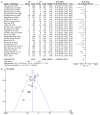Radial versus femoral artery access for percutaneous coronary angiography and intervention: a systematic review and meta-analysis of randomized controlled trials in Chinese population
- PMID: 26770309
- PMCID: PMC4694209
Radial versus femoral artery access for percutaneous coronary angiography and intervention: a systematic review and meta-analysis of randomized controlled trials in Chinese population
Abstract
To compare the feasibility, efficiency and safety of coronary angiography (CAG) and interventional procedures between the radial and femoral catheterization approaches in Chinese population using systematic review and meta-analysis, we conducted a search of the studies comparing radial and femoral catheterization approaches in patients underwent either CAG or percutaneous coronary intervention (PCI) in Chinese population. Fixed-effect relative risk (RR) for the primary end points and the second end points were compared between the two approaches. A total of 27 studies (n=8,749 patients) were finally included in the analysis. The success rate of radial approach was slightly lower than that of femoral approach in patients receiving CAG (P=0.004), but similar in patients receiving a further PCI treatment (P=0.11). The risk of major adverse cardiovascular events (MACEs) was similar between two approaches (P=0.27). Radial catheterization had a significantly lower rate of puncture site complications (P<0.00001), but a lower rate of puncture success rate (P=0.02). In patients with acute myocardial infarction (AMI), there was no difference in neither the risk of MACEs nor PCI success rate between two approaches (P=0.23 and 0.45, respectively), but a board line decrease of puncture success rate was observed in radial catheterization group (P=0.04). There were no significant differences in the volumes of contrast media, X-ray exposure time and operation time between the two approaches (all P>0.05). Thus, we concluded that radial approach is a safe method for CAG or PCI compared to traditional femoral approach in Chinese population due to their similar success rate of the procedure and risk of MACEs, and a decreased risk of puncture site complications.
Keywords: Radial artery; acute myocardial infarction (AMI); coronary angiography (CAG); coronary disease; femoral artery; meta-analysis; percutaneous coronary intervention (PCI); systematic review.
Figures









References
-
- Campeau L. Percutaneous radial artery approach for coronary angiography. Cathet Cardiovasc Diagn. 1989;16:3–7. - PubMed
-
- Kiemeneij F, Laarman GJ. Percutaneous transradial artery approach for coronary stent implantation. Cathet Cardiovasc Diagn. 1993;30:173–178. - PubMed
-
- Kiemeneij F, Laarman GJ, Odekerken D, Slagboom T, van der Wieken R. A randomized comparison of percutaneous transluminal coronary angioplasty by the radial, brachial and femoral approaches: the access study. J Am Coll Cardiol. 1997;29:1269–1275. - PubMed
-
- Louvard Y, Benamer H, Garot P, Hildick-Smith D, Loubeyre C, Rigattieri S, Monchi M, Lefèvre T, Hamon M OCTOPLUS Study Group. Comparison of transradial and transfemoral approaches for coronary angiography and angioplasty in octogenarians (the OCTOPLUS study) Am J Cardiol. 2004;94:1177–1180. - PubMed
-
- Louvard Y, Lefevre T, Allain A, Morice M. Coronary angiography through the radial or the femoral approach: The CARAFE study. Catheter Cardiovasc Interv. 2001;52:181–187. - PubMed
LinkOut - more resources
Full Text Sources
Miscellaneous
